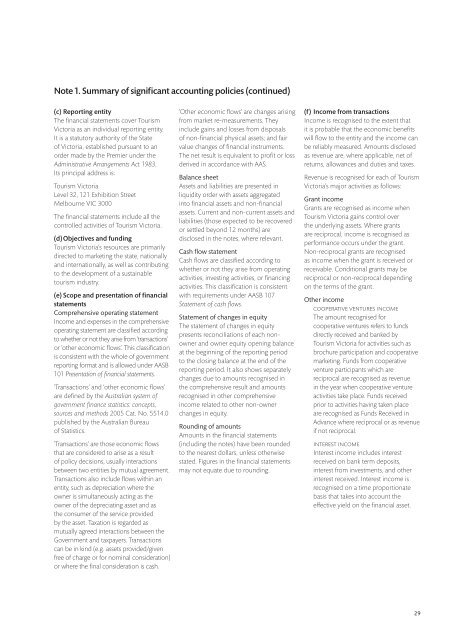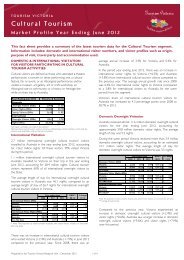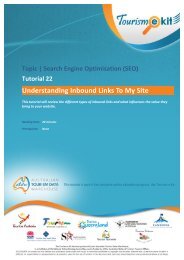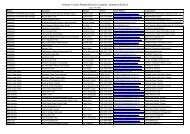Annual Report 2010–2011, Part 2: Financial (1.8 ... - Tourism Victoria
Annual Report 2010–2011, Part 2: Financial (1.8 ... - Tourism Victoria
Annual Report 2010–2011, Part 2: Financial (1.8 ... - Tourism Victoria
You also want an ePaper? Increase the reach of your titles
YUMPU automatically turns print PDFs into web optimized ePapers that Google loves.
Note 1. Summary of significant accounting policies (continued)<br />
(c) <strong>Report</strong>ing entity<br />
The financial statements cover <strong>Tourism</strong><br />
<strong>Victoria</strong> as an individual reporting entity.<br />
It is a statutory authority of the State<br />
of <strong>Victoria</strong>, established pursuant to an<br />
order made by the Premier under the<br />
Administrative Arrangements Act 1983.<br />
Its principal address is:<br />
<strong>Tourism</strong> <strong>Victoria</strong><br />
Level 32, 121 Exhibition Street<br />
Melbourne VIC 3000<br />
The financial statements include all the<br />
controlled activities of <strong>Tourism</strong> <strong>Victoria</strong>.<br />
(d) Objectives and funding<br />
<strong>Tourism</strong> <strong>Victoria</strong>’s resources are primarily<br />
directed to marketing the state, nationally<br />
and internationally, as well as contributing<br />
to the development of a sustainable<br />
tourism industry.<br />
(e) Scope and presentation of financial<br />
statements<br />
Comprehensive operating statement<br />
Income and expenses in the comprehensive<br />
operating statement are classified according<br />
to whether or not they arise from ‘transactions’<br />
or ‘other economic flows’. This classification<br />
is consistent with the whole of government<br />
reporting format and is allowed under AASB<br />
101 Presentation of financial statements.<br />
’Transactions’ and ‘other economic flows’<br />
are defined by the Australian system of<br />
government finance statistics: concepts,<br />
sources and methods 2005 Cat. No. 5514.0<br />
published by the Australian Bureau<br />
of Statistics.<br />
’Transactions’ are those economic flows<br />
that are considered to arise as a result<br />
of policy decisions, usually interactions<br />
between two entities by mutual agreement.<br />
Transactions also include flows within an<br />
entity, such as depreciation where the<br />
owner is simultaneously acting as the<br />
owner of the depreciating asset and as<br />
the consumer of the service provided<br />
by the asset. Taxation is regarded as<br />
mutually agreed interactions between the<br />
Government and taxpayers. Transactions<br />
can be in kind (e.g. assets provided/given<br />
free of charge or for nominal consideration)<br />
or where the final consideration is cash.<br />
’Other economic flows’ are changes arising<br />
from market re-measurements. They<br />
include gains and losses from disposals<br />
of non-financial physical assets; and fair<br />
value changes of financial instruments.<br />
The net result is equivalent to profit or loss<br />
derived in accordance with AAS.<br />
Balance sheet<br />
Assets and liabilities are presented in<br />
liquidity order with assets aggregated<br />
into financial assets and non-financial<br />
assets. Current and non-current assets and<br />
liabilities (those expected to be recovered<br />
or settled beyond 12 months) are<br />
disclosed in the notes, where relevant.<br />
Cash flow statement<br />
Cash flows are classified according to<br />
whether or not they arise from operating<br />
activities, investing activities, or financing<br />
activities. This classification is consistent<br />
with requirements under AASB 107<br />
Statement of cash flows.<br />
Statement of changes in equity<br />
The statement of changes in equity<br />
presents reconciliations of each nonowner<br />
and owner equity opening balance<br />
at the beginning of the reporting period<br />
to the closing balance at the end of the<br />
reporting period. It also shows separately<br />
changes due to amounts recognised in<br />
the comprehensive result and amounts<br />
recognised in other comprehensive<br />
income related to other non-owner<br />
changes in equity.<br />
Rounding of amounts<br />
Amounts in the financial statements<br />
(including the notes) have been rounded<br />
to the nearest dollars, unless otherwise<br />
stated. Figures in the financial statements<br />
may not equate due to rounding.<br />
(f) Income from transactions<br />
Income is recognised to the extent that<br />
it is probable that the economic benefits<br />
will flow to the entity and the income can<br />
be reliably measured. Amounts disclosed<br />
as revenue are, where applicable, net of<br />
returns, allowances and duties and taxes.<br />
Revenue is recognised for each of <strong>Tourism</strong><br />
<strong>Victoria</strong>’s major activities as follows:<br />
Grant income<br />
Grants are recognised as income when<br />
<strong>Tourism</strong> <strong>Victoria</strong> gains control over<br />
the underlying assets. Where grants<br />
are reciprocal, income is recognised as<br />
performance occurs under the grant.<br />
Non-reciprocal grants are recognised<br />
as income when the grant is received or<br />
receivable. Conditional grants may be<br />
reciprocal or non-reciprocal depending<br />
on the terms of the grant.<br />
Other income<br />
cooperative ventures income<br />
The amount recognised for<br />
cooperative ventures refers to funds<br />
directly received and banked by<br />
<strong>Tourism</strong> <strong>Victoria</strong> for activities such as<br />
brochure participation and cooperative<br />
marketing. Funds from cooperative<br />
venture participants which are<br />
reciprocal are recognised as revenue<br />
in the year when cooperative venture<br />
activities take place. Funds received<br />
prior to activities having taken place<br />
are recognised as Funds Received in<br />
Advance where reciprocal or as revenue<br />
if not reciprocal.<br />
Interest income<br />
Interest income includes interest<br />
received on bank term deposits,<br />
interest from investments, and other<br />
interest received. Interest income is<br />
recognised on a time proportionate<br />
basis that takes into account the<br />
effective yield on the financial asset.<br />
29
















